How to Set Stop Loss Levels
InvestorEducation / Learning to Invest Apr 10, 2010 - 02:12 AM GMTBy: Richard_Shaw
 We increasingly receive questions about how to set stop loss levels. Let’s look at one objective, data driven way to do that.
We increasingly receive questions about how to set stop loss levels. Let’s look at one objective, data driven way to do that.
You may be a better way, and that’s good thing, but if you don’t have a way, and you need a way, this discussion may be a helpful starting place to design your own stop loss setting method.
This discussion is not relevant to short-term trading, and would not be useful to those who do not believe in exiting positions (who are strict “buy and hold” adherents), to those with very long-term horizons AND iron stomachs capable of withstanding large fluctuations in portfolio value, or to those who would have the opposite reaction of a stop and instead wish to buy more when their positions tank.
First, recognize these three important concepts:
- you want your stops to be outside of the “noise” level of seemingly random price fluctuation
- you want your stops to be outside of the “reaction” range that is likely to occur
- you want your stops to be within your personal emotional or financial limits.
If you place stops outside of “reaction” levels, you will automatically be outside of the “noise” level. If the “reaction” level is outside of your personal emotional or financial limits, then you probably should not own the security.
Your personal limits are something only you can know.
“Reaction” levels may be reasonably estimated by examining three quantitative parameters that are easily accessible, and then setting your stops outside of the greater of the three. We think these three parameters each divided by the price are informative and useful in selecting a stop loss percentage for trailing percentage stops:
- the width of the 3-month price channel
- the width of the 3-month 2 standard deviation Bollinger Bands
- the spread between the price and the 200-day simple moving average
It may also be good to consider the 3-month average of the 3-month Bollinger Band width as an additional parameter.
As an example, if you were to do that today to see where percentage trailing stops might be set for six ETFs representing key asset categories, we come up with these values:
- US stocks (VTI) 13.6%
- EAFE stocks (VEA) 14.2%
- Emerging market stocks (VWO) 17.4%
- Aggregate US bonds (BND) 2.0%
- Developed non-US sovereign local currency bonds (BWX) 7.0%
- Emerging market sovereign Dollar bonds (EMB) 7.2%
We must admit that the 2% on aggregate US bonds seems thin, but that’s what the current numbers say. If you feel the same way, you might chose a longer term factor, maybe as far as the current yield level of 3.9% (so you would do no more than give up the equivalent of one year of income, but not principal).
Note also that for BWX, the price is below the 200-day simple moving average so there is no way to use that parameter in the stop calculation — except to say that we think you should not own it while the price is below the 200-day average — unless you have some special knowledge or beliefs about the Euro/Dollar and the Dollar/Yen, and the European sovereign credit crisis.
Here is the raw data we used to calculate the stop levels above:
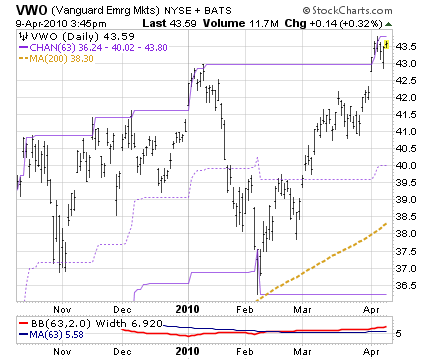
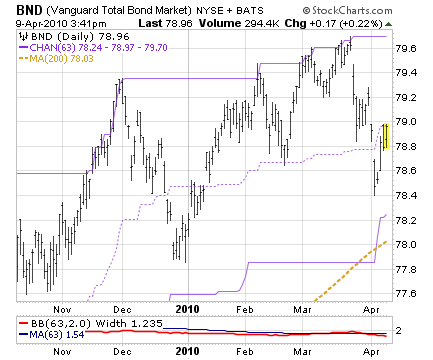
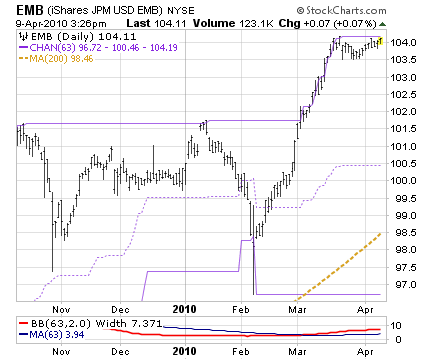
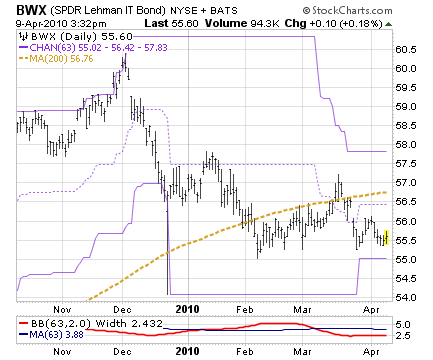
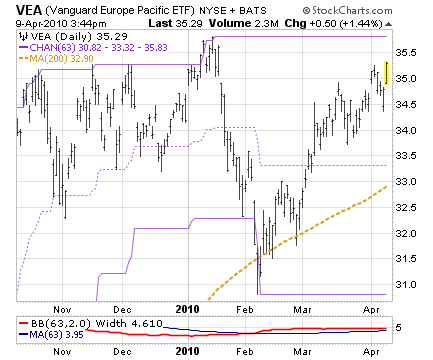
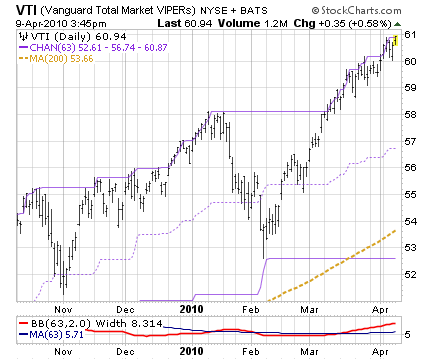
Holdings Disclosure:
As of April 9, 2010, we hold BND, EMB, and VWO in some, but not all managed accounts, and not necessarily all in any single account. We do not have current positions in any other securities discussed in this document in any managed account.
By Richard Shaw
http://www.qvmgroup.com
Richard Shaw leads the QVM team as President of QVM Group. Richard has extensive investment industry experience including serving on the board of directors of two large investment management companies, including Aberdeen Asset Management (listed London Stock Exchange) and as a charter investor and director of Lending Tree ( download short professional profile ). He provides portfolio design and management services to individual and corporate clients. He also edits the QVM investment blog. His writings are generally republished by SeekingAlpha and Reuters and are linked to sites such as Kiplinger and Yahoo Finance and other sites. He is a 1970 graduate of Dartmouth College.
Copyright 2006-2010 by QVM Group LLC All rights reserved.
Disclaimer: The above is a matter of opinion and is not intended as investment advice. Information and analysis above are derived from sources and utilizing methods believed reliable, but we cannot accept responsibility for any trading losses you may incur as a result of this analysis. Do your own due diligence.
Richard Shaw Archive |
© 2005-2022 http://www.MarketOracle.co.uk - The Market Oracle is a FREE Daily Financial Markets Analysis & Forecasting online publication.



